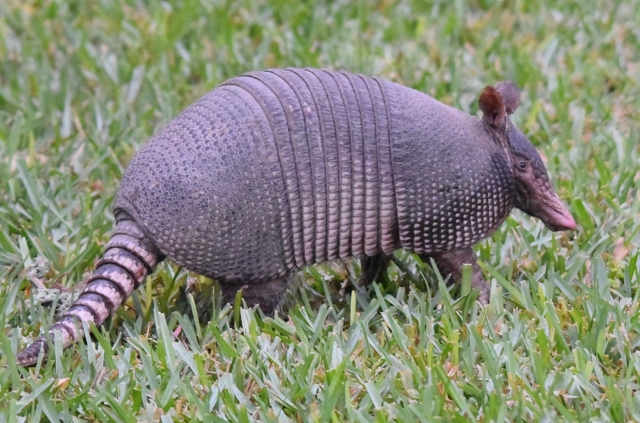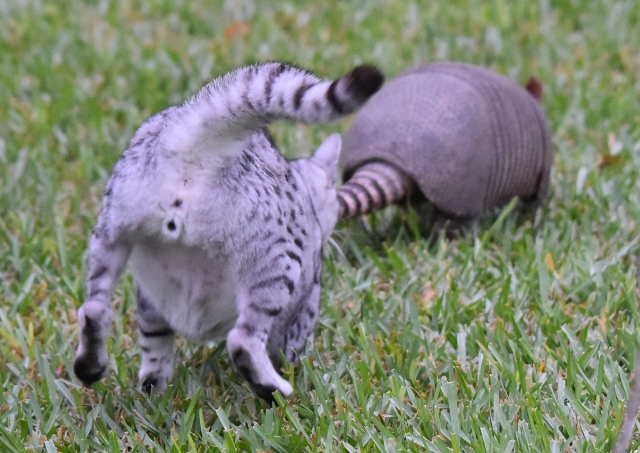Thanks to the cat, I finally captured a decent shot of one of our resident yard-fellows.
During the recent Great Backyard Bird Count, I was out with the cats and camera just after sunrise on a foggy grey day, when suddenly, the cats did their something-wicked-this-way-comes pose: statue still, rigid side stance, arched back and bristled fur.
I looked in the direction the cats were glaring, raised the camera and tripped off a quick shot.

And the next moment, Alex charged!

To Alex, this seemingly weekly event is a great challenge. The Egyptian Mau can run 30 miles an hour, reputedly faster than any other breed of domestic cat in the world, according to Internet sites.
The nine-banded armadillo also can run up to 30 miles an hour. Fortunately, Alex stops — mostly — when I yell his name. Game over. The armadillo lopes across the yard to his den, and Alex, with the attention span of a gnat, goes on to hunt rabbits and rats.
The only species of armadillo in the United States is the nine-banded armadillo. Approximately 20 species of armadillo exist throughout Central and South America.
Nine-banded armadillos are throughout Texas except in the Panhandle and the far west Texas mountains and desert of the Trans-Pecos. The species is found as far north as southeast Nebraska and Illinois, and east through Tennessee, Georgia and South Carolina. Despite cold climates, the armadillos seem to be expanding their range northward; some say the expansion will stop where food supplies aren’t available during winter. Armadillos don’t hibernate, so must always forage for food.
Generally seen trundling along, snuffling at the ground, with a slight sweeping motion of its head, the nine-banded armadillo can approach speeds to 30 miles an hour when fleeing a predator. There’s not much for them to fear in the Valley except coyotes and vehicular traffic, and perhaps the occasional cat; further north, and in Louisiana, they are prey to mountain lions, black bears and alligators.
The name armadillo means “little armored one” in Spanish. The armadillo’s shell is made up of bone plates, known as scutes, which are covered in overlapping scales and connected by flexible, leathery skin. It is the only mammal that has bone plates in its skin. The critter has additional protection on the top of its head, upper limbs and tail. The underside has only soft skin and fur.
These unique-looking creatures are about two and a half feet long from nose to tail tip and weigh about 12 pounds. Contrary to popular belief, only the Brazilian three-banded armadillo can roll itself into a ball to foil a predator. The nine-banded armadillo has to rely on dense shrubs in which to hide, or scurry to one of several burrows it has dug out around its territory.
Nine-banded armadillos are nocturnal in the summer and diurnal (active in the day time) during winter. They are very sensitive to temperature because they have poor insulation under their armor. In winter, they tend to be active during the warmest part of the day, in summer, at night and early morning, when it’s cooler.
Armadillos are mainly insectivores. They have poor eyesight, but excellent hearing and a very keen sense of smell. They eat beetles, larvae, worms, termites, cockroaches, fire ants, scorpions, white grubs, grasshoppers, ants, maggots and snails as well as a small amount of fruit, seeds, fungi and other plant matter. They also eat spiders, snakes and frogs. Their diet is regional- and habitat-dependent.
Ever helpful in ridding a yard of many pests, especially those voracious grass-killing grubs, they unfortunately root out their fare by digging with their large, sharp, thick, strong claws. They leave a yard full of annoying holes for the property owner to find.
Armadillos generally take up residency near water, which doesn’t define their territorial border. The nine-banded species can hold its breath for up to six minutes and cross a stream or resaca by walking along the bottom. Alternately, it can gulp air into its digestive track for buoyancy which enables it to swim. They have a strong doggy-paddle stroke.
Armadillos have a history as a food source for humans. The nine-banded armadillo was nicknamed “poor man’s pork” and “Hoover hog” by people who blamed President Hoover for the Great Depression, according to armadillo-online.org.
On the other hand, it’s true that armadillos are the only animals that can contract leprosy from humans and pass it on to other humans. Scientists believe that in order to contract leprosy from an armadillo, one must frequently handle the animals, and/or consume armadillo meat.
There’s more . . . . There’s a Google tag that asks, “Are armadillos bulletproof?” that reveals funny-if-it-doesn’t-happen-to-you stories where bullets apparently ricochet off armadillo battle armor and injure the shooter, or those nearby.
Sources that were helpful in writing about the nine-banded armadillos include the Wildlife Forever, Texas Wildlife Association and San Antonio Livestock Exposition, Inc., publication, “Critters of Texas Pocket Guide,” Adventure Publications, Inc.
Online sources include National Wildlife Federation, havahart and a-z-animals.

Leave a Reply